Blog, Destinations, Peru, South America
Peru Travel Guide: Hiking the Salkantay Trek to Machu Picchu
Last updated on July 29th, 2024 at 04:56 pm
It was 4:30 am, the morning after St. Patrick’s Day and I stood on the sidewalk in the pouring rain. I was not returning from a night out celebrating St. Patrick, I was awaiting a bus to pick me up, signaling the start of my Salkantay trek to Machu Picchu. As the cars passed by splashing big puddles on my once dry legs, I was excited and nervous about the journey ahead.
At the briefing meeting the night before, where our guides told us what to pack, what to expect with the altitude and answered all of our questions, I met the others in my hiking group as well as our two guides for the trek. Our group for the next four days consisted of:
- three friends from Colorado
- a mother and daughter pair with the daughter’s guy friend from Uruguay
- three Swedish women traveling together
- a woman from Mexico
- a man from Spain
- and myself.
We would all be together for the next 5 day, a 75-kilometer trek, with the highest point of the trek reaching 4900m (16,000ft) on the Salkantay pass as we made our way on the Salkantay trek to Machu Picchu.
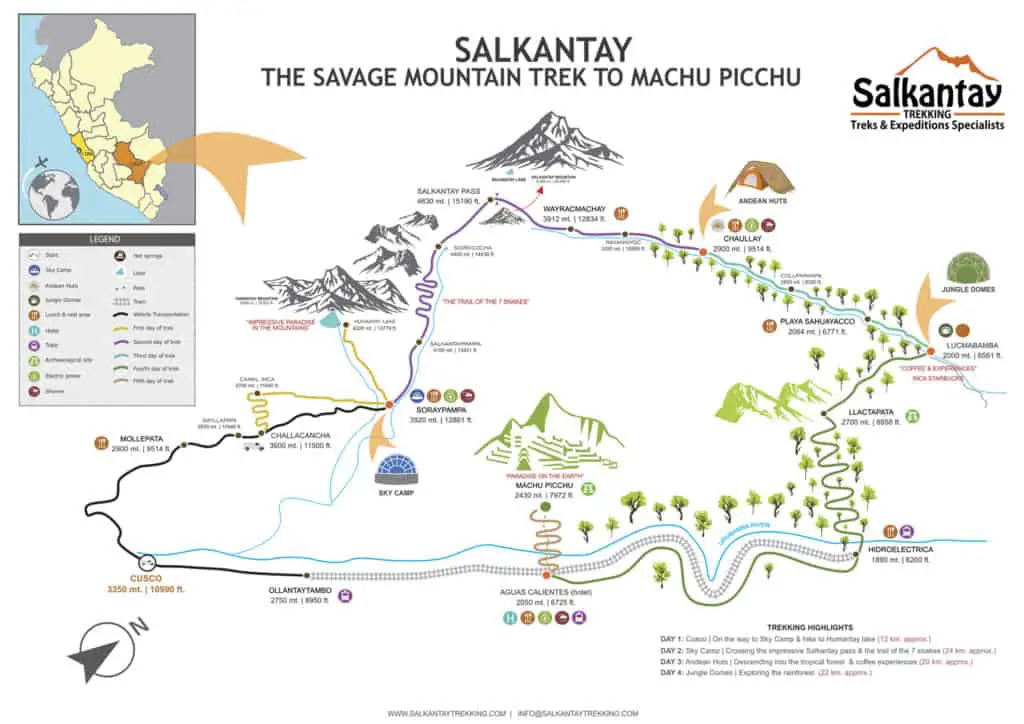
The rain unrelenting as the bus pulled up with the three Coloradans and three Swedes already seated. We made our way throughout Cusco picking up the remainder of our group. Once we were all present and accounted for, our guides passed out blankets to keep us warm in the early morning chill. Despite my excitement for the upcoming adventure, I huddled under the blanket and promptly drifted off to sleep.
The rain was unrelenting as the bus pulled up with the three Coloradans and three Swedes already seated. We made our way throughout Cusco, picking up the remainder of our group. Once we were all present and accounted for, our guides passed out blankets to keep us warm in the early morning chill. Despite my excitement for the upcoming adventure, I huddled under the blanket and promptly drifted off to sleep.
This post contains affiliate links, which means that, at no additional cost to you, I will earn a tiny bit of income if you decide to make a purchase or booking.
peru travel resources
- Book your flight to Peru with Omio
- Get reliable travel insurance with World Nomads
- Find awesome accommodation with booking.com or Hostelworld
- Want to add guided tours to your itinerary? Here are the top 10 tours in Peru
- The best way to see Peru in a week!
- Get the essentials for trip to Peru here: my favorite waterproof booties, this power bank to stay connected, and a reusable water bottle
Getting to Know My Trekking Companions
Our guides woke us about an hour later for breakfast. The sky was still cloudy, but the sun was up, and the rain turned to a light drizzle. Over a hearty breakfast of eggs, toast, fruit, and tea, I began to get to know my fellow hikers.
Learning how their life brought them to that breakfast table. Some, like me, were traveling for a few months, and this was a bucket list item on their itinerary. Others came to Peru exclusively to hike this trail. Some in the group spoke only Spanish and I was excited for the opportunity to practice my Spanish with them over the next few days!
We climbed back into the bus, and after a 45-minute drive on a very narrow, winding mountain road, we reached our starting point. Our guides unloaded our bags, laying them on a tarp to prevent them from getting muddy and wet. I removed my rain gear from my duffel bag, thankful I’d purchased rain pants the day prior, as I pulled them on over my hiking pants.
Our guides gave us a snack bag filled with fruit, cookies, and a water bottle, which I put in my daypack for the trail. Then, we began walking.
Day 1 of the Salkantay Trek: Cusco to Soraypampa
As we walked in the intermittent rain, we continued conversations left over from breakfast. Learning more about the languages spoken, the different histories and journeys of my fellow trekkers. Although our paths leading us here were quite different, we all came together with a common goal of safely reaching Machu Picchu.

We passed waterfalls, some always in existence, some created from the current rainy season. We walked along irrigation canals that the farmers in the area used during the dry season for their crops, obviously not in use at this time of the year.
Our guides paused to check on us as we crossed rivers and streams. They used our breaks to tell us about the history of the area or show us plants used in food or for medicinal purposes by the Incas.
After about three hours of walking along the mostly flat trail, we made it to our first campsite.
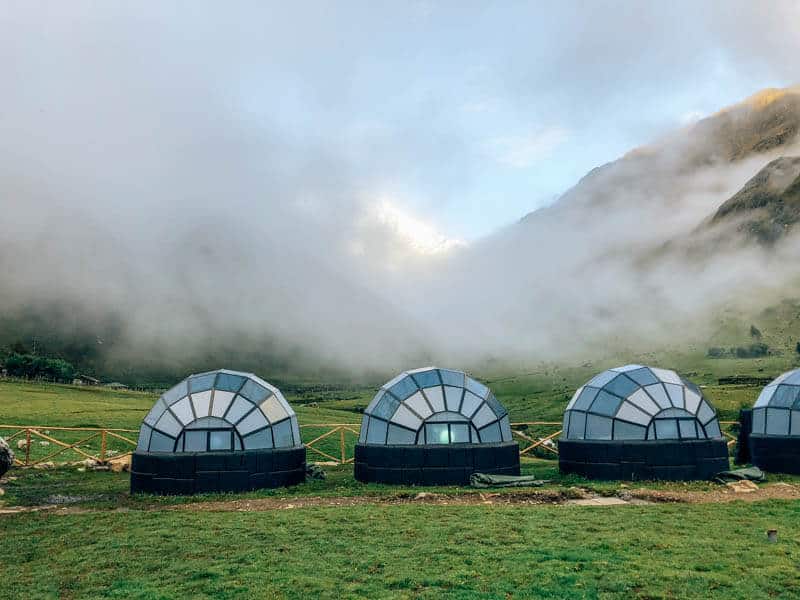
Our chefs were already there and ready with our first lunch of the trek. They served family style bowls of soup, plates of rice, bowls of soup, veggies, and chicken.
We were given free time for a brief nap in our sky domes before our first test of the trek began.
Hiking to Humantay Lake
Humantay Lake is nestled at an altitude of 4200m (13,780 ft). Our guides said if we could make it up with minimal altitude issues, they were confident we could hike the Salkantay pass the following day.

The hike began just behind our campsite. It was a fairly steep and very muddy hour and a half-climb up. As I got closer to the top, I had to pause multiple times to catch my breath. Finally, with a sigh of relief, I crossed over the crest and looked down into the crystal blue waters of Humantay Lake. The rain and fog cleared, allowing us to fully appreciate the deep turquoise blue waters reflecting the mountains surrounding it.
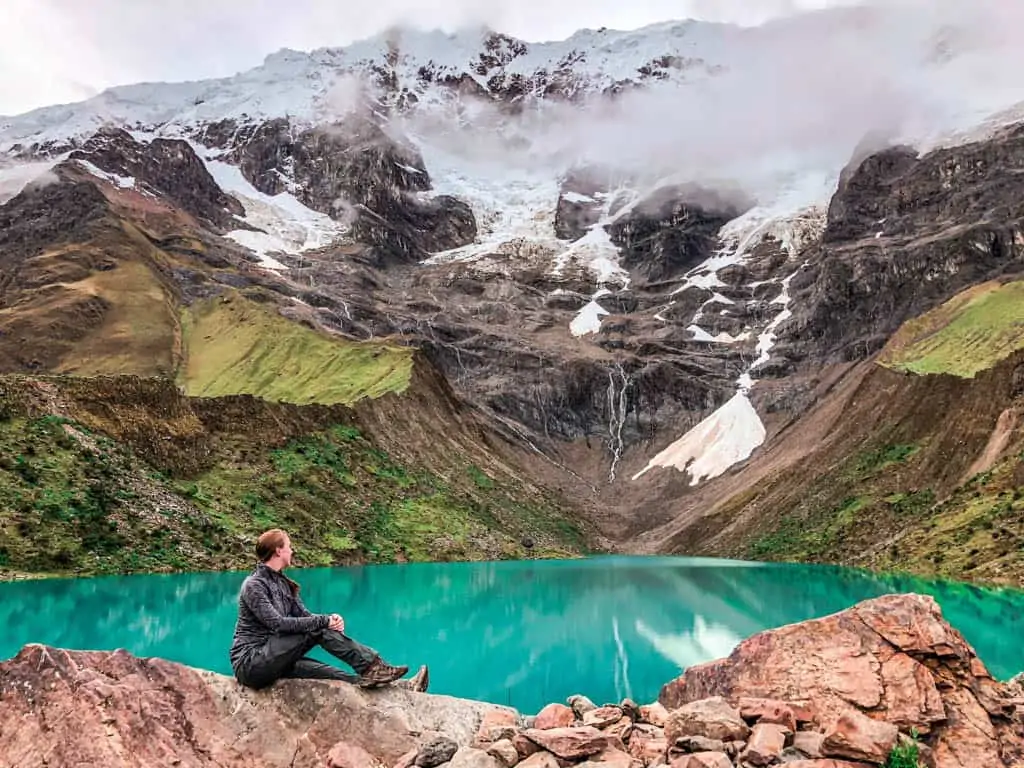
Our Guide’s View on Ayahuasca
Here, our guide described to us the Incan connection with the earth. Humantay Lake was used as a place to pay respect to Pachamama (Mother Earth) and honor her life-giving forces. We discussed Ayahuasca and its increasing popularity in tourism.
He shared the importance of honoring the sacred tradition of the Ayahuasca herbs by preparing the body and mind for the experience.
He believed that when the person is ready, Ayahuasca will find the person, and it’s better not to seek it out.
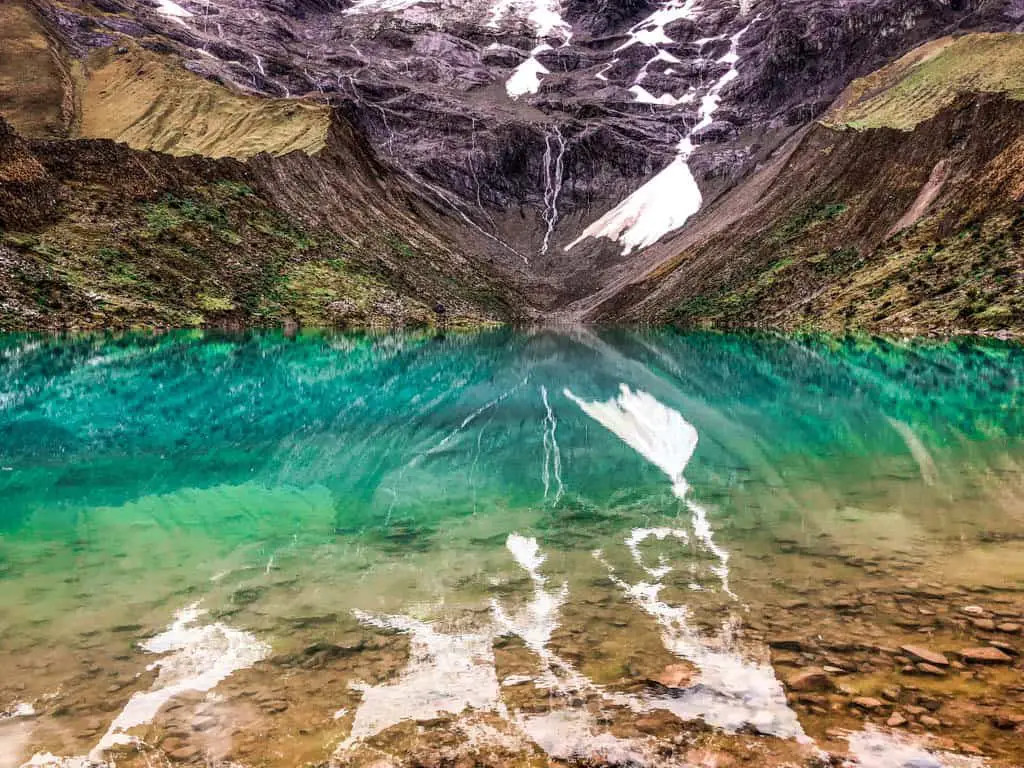
Dealing with the Altitude
Upon return to camp, we settled in for a nice family dinner, speaking animatedly about the next day. A few members of our group experienced some altitude sickness on the way to Humantay Lake. They were deciding whether or not they would take a horse up to the Salkantay pass, attempt walking, or maybe just take the bus back to Cusco and meet us in Aguas Calientes.
The beauty of this trek is that there are plenty of options for people of all capabilities. Ultimately, two decided to take a horse to Salkantay Pass and one decided to turn back to Cusco.
I turned in to my skydome early, to prep for the following day.
These sky domes were the reason I chose this trek over the Inca Trail. The glass dome allows you to look into the starlit sky with no other light pollution around. The imposing Salkantay mountain gazing upon you.
However, on this night, all I saw were the droplets of water running down the side as the rain poured down.
Lodging Night One: Skydomes in Soraypampa
Day 2 of the Salkantay Trek: Soraypampa to Chaullay
4:30 in the morning, pitch black, no cars, no honking, just a light tap on our door and our guides handing us a piping hot cup of coca tea. Waking us up for the most physically challenging day of the trek ahead. We were to hike for a total of 10 hours, four hours up to the Salkantay pass at 4900m (16,000 ft!) and 6 hours hiking back down to our second campsite.
I prayed the rain would hold off for the majority of the day as I loaded up my duffle bag, made sure I had my rain gear and snacks, filled up my water, and headed out.
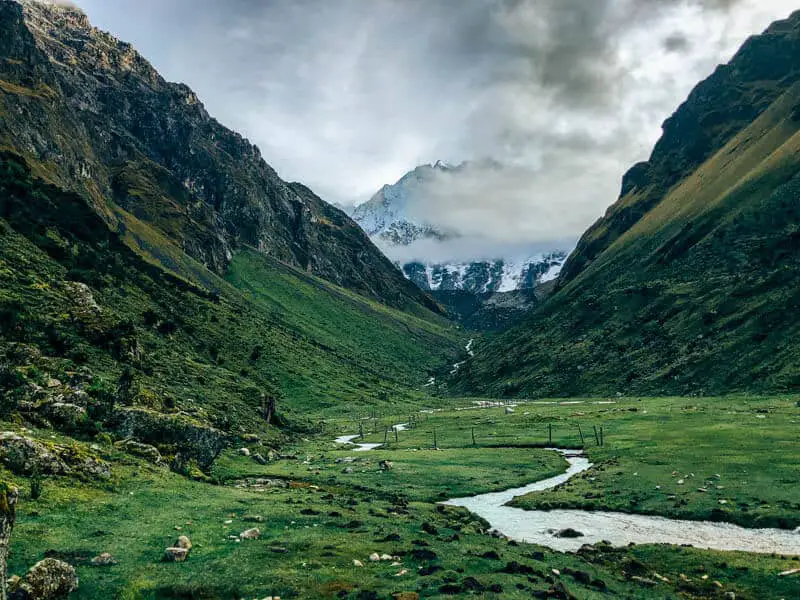
As the sun rose, we began our hike in a quiet, single file line. Each of us mentally preparing for the physical challenge ahead. The skies were clear as we walked on and we started playing what our tour guide affectionately called the “layer game”. Taking layers off as we walked only to put them back on when we took breaks.
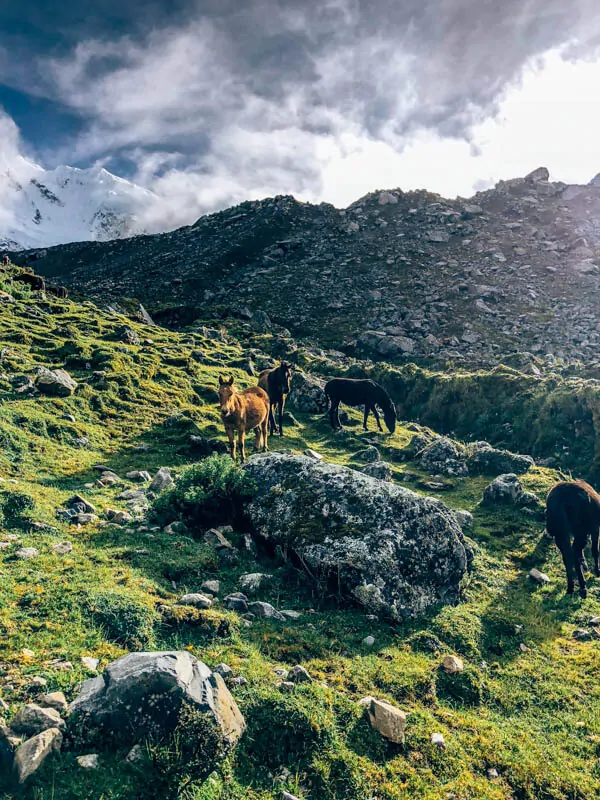
The Seven Snakes
We made it to the 7 snakes – a section of seven switchbacks where the donkeys carrying our food and our friends finally passed us. Back and forth and back and forth we walked, stopping as much as we needed. There was no rush from our guides. The mountain wasn’t going anywhere.
Eventually, we passed through a field with massive boulders, the evidence of avalanches from the Salkantay mountain. Boulders that had been there ages before me and will continue to be there ages after me. It looked like something from Jurassic Park.
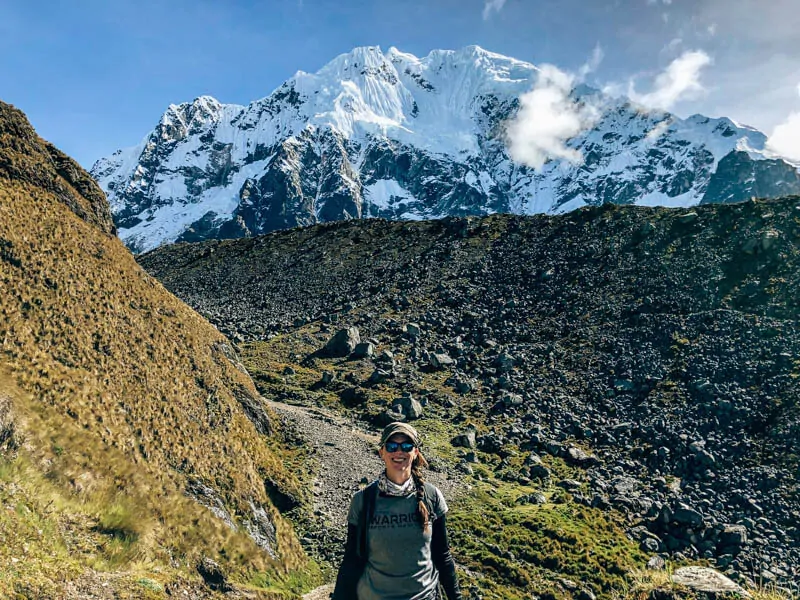
You wouldn’t think that there’s much of a difference between 4600m where these boulders lay and 4900m where we were headed, but let me tell you – every four or five steps, I needed a break to drink water and catch my breath.
I had a wad of coca leaves permanently in my cheek. Hoping that the leaves’ anti-altitude attributes actually worked.
Yet as slowly as I moved, I could see myself getting closer and closer to the pass.
The peak of the mountain becoming clearer and clearer with each breathless step.
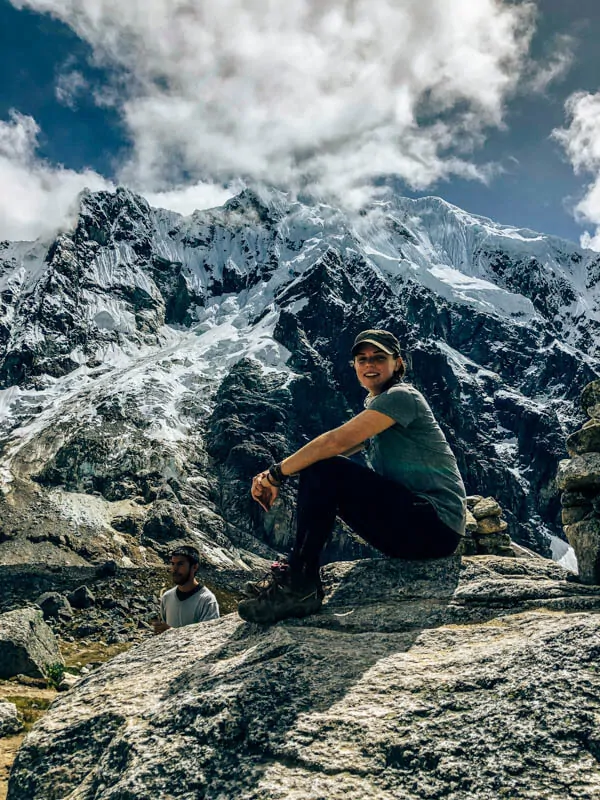
The Salkantay Pass
Then with a last final push, I came to the top of the pass. A place I’d been dreaming of seeing ever since I booked my ticket. The peak of Salkantay playing hide and seek with the passing clouds. A condor flew overhead, as our guide told us the name Salkantay stands for Wild Woman due to its many avalanches.
Only one group of three foreigners successfully summited the mountain, many others attempted, yet did not return.
Instead of attempting to summit Salkantay, the Incas paid respect to her power, bringing offerings to this location for a successful harvest.
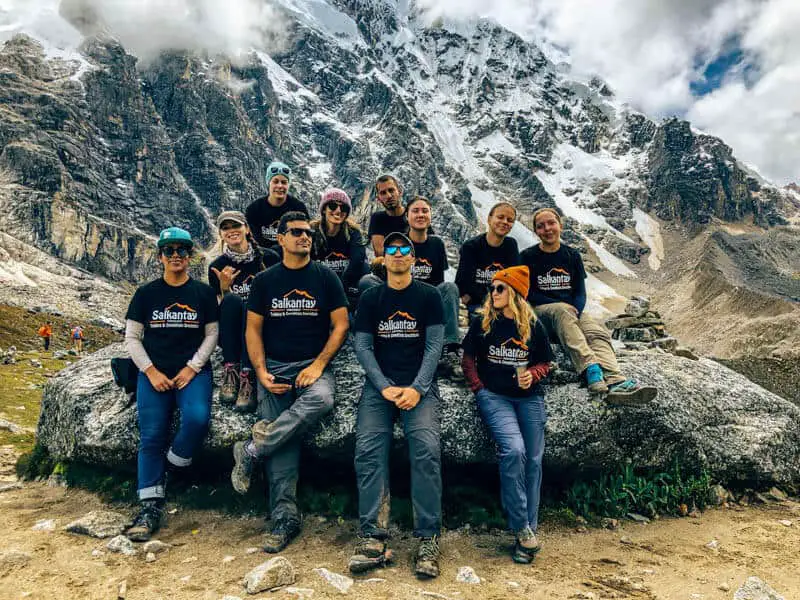
As we sat, drinking more coca tea, eating sandwiches, I felt humbled by my surroundings. In awe of the people who lived in this valley, their ancestors, and their reverence to the earth. And I felt damned proud of myself for making it up the mountain!
What goes up, must come down
I still can not tell you whether going uphill or downhill is more difficult. My knees are of the opinion that downhill is harder, especially when it’s a rocky, downhill path for about 5 out of those 6 hours. The rain came in and out, sometimes a drizzle, sometimes a downpour. The layer game continued as I tried to decide whether it was worth putting my rain gear on for a drizzle. One time making the wrong choice as the sky opened and I got thoroughly drenched. Our guide trying his best to keep our spirits up, telling us:
Just a little bit further, just a little bit further, ten more minutes, ten more minutes…
For about 40 minutes.
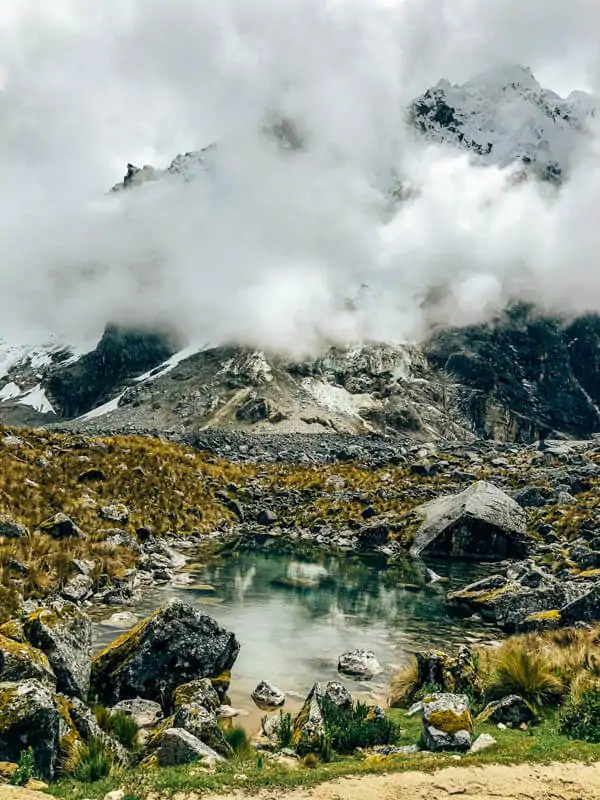
The group began to split up a bit more now. More advanced hikers (like the Coloradoans) in the front of the pack, slower in the back. There wasn’t much of a middle.
I was proud of my spot bringing up the rear for the majority of the day. It was easier to keep up the day prior as we were at lower altitudes. But today it definitely felt as though I was running, even though I was simply walking, to keep up with the Coloradoans at the front of the pack.
So I decided to just go at my own pace, our guides not rushing us, let us take as much time as we needed despite the rain. As we moved step by step to our campsite.
Just ten minutes more, just ten minutes more
Walking in ten-minute intervals trying not to check my watch. Because the time didn’t matter – the only option I had was to keep putting one foot in front of the other. For a total of ten hours, in one day. Upon arrival at camp, it felt amazing to take off my boots and let my feet breathe!
I’m so thankful, I sprang for my waterproof boots and a good pair of hiking socks because my feet, though aching, were dry and blister-free!
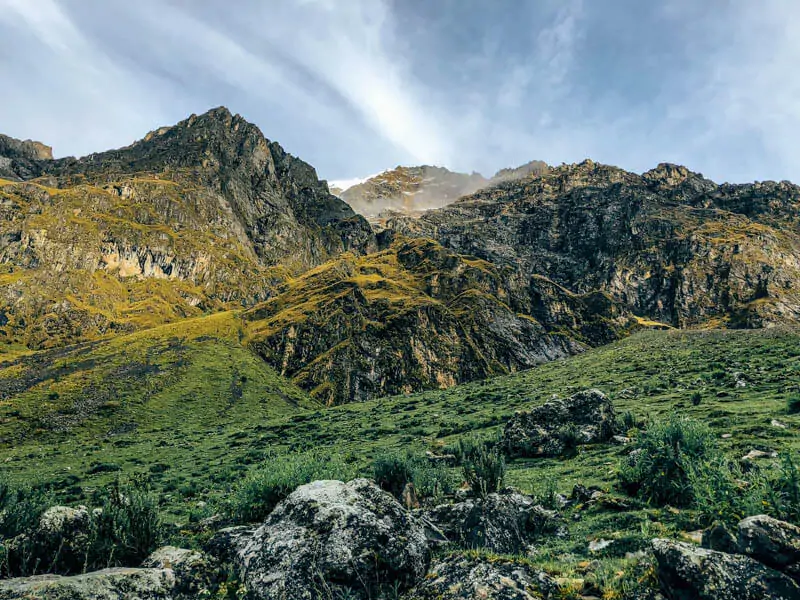
That night, we ate another amazing meal, played a card game, and finally drifted off into a very deep sleep. Only to be woken again at 4:30 in the morning with a hot cup of coca tea and our guides gently drawing us out of our tents and into the break of dawn.
Lodging Night Two: Tents in Chaullay
Day 3 of the Salkantay Trek: Chaullay to Lucmabamba
Or as I like to call it, the day of landslides, waterfalls, and hot springs.
Walking down Landslides
Today is the day we were all looking forward to. We would be ending the day in hot springs. That thought helped me put one foot in front of the other as it poured relentlessly for the first hour of the trek. Landslides in the area forced us to crisscross over the ravine.
Two by two we sat in a cable car as locals pulled us across the ravine. At one point we were walking along a narrow path, the mountain to our left and steep drop off to our right when we were told to turn back about 10 minutes to another cable car as there was an unexpected landslide that seemed impassable.
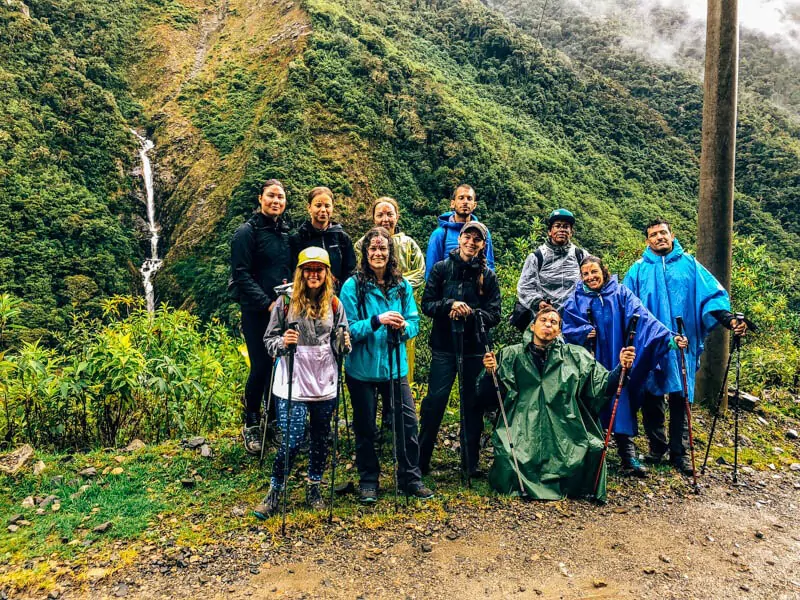
We patiently waited for our turn on the cable car, huddling under a shelter, playing cards to pass the time. One of our guides was working intensively pulling the cable car as fast as he could, trying to get other hikers across.
The second guide disappeared for about twenty minutes, returning with the news that we could climb down the landslide.
Ummm, what?
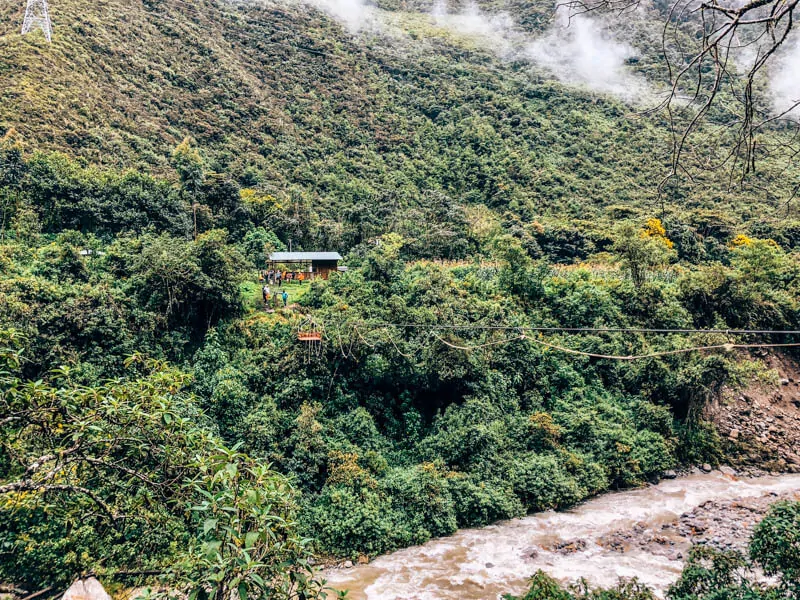
We walked back and discovered why we were turned around in the first place. The side of the mountain and path washed away, leaving a pile of very unstable rubble and mud.
It was definitely sketchy, but our guides hadn’t failed us yet.
So we handed over our hiking poles as sticking it into the mud might cause another landslide and quickly zigzagged down to the bridge below, where we walked across the ravine.
Happy to say all of us at that moment made it safely down without any issues!
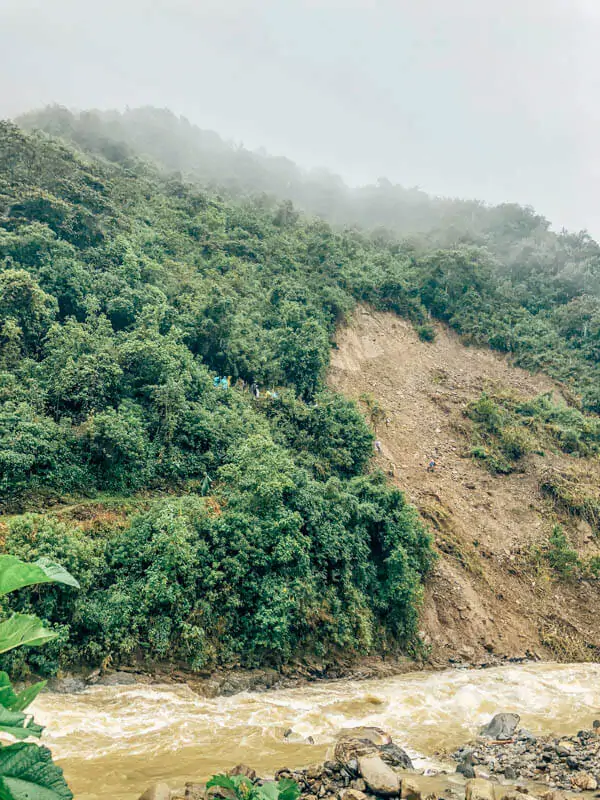
Crossing the Waterfall
As the rain dissipated, we stopped at a local fruit stand where I happily cut open a granadilla. A perfect mid-hike snack. We paid our soles to use the facilities and continued on. Not more than 300 meters later we came to a waterfall.
The mountain dropping to our left this time, we were to cross in its pool just on the edge of the drop.
Our guide urging us ahead saying “don’t worry about wet feet, just get across”.
Giving thanks again for my waterproof boots I stepped into the ankle-deep water.
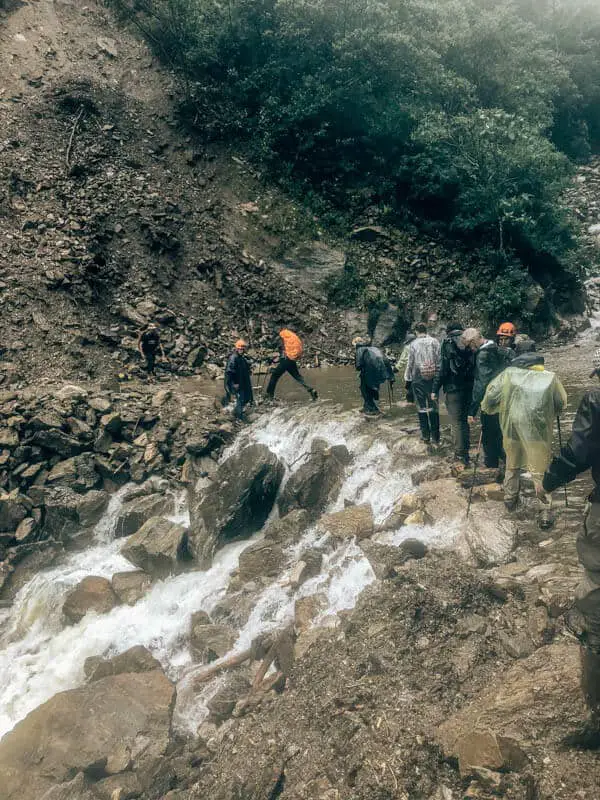
There were two government workers at the waterfall, surveying the landslides in the area and ensuring that they would get fixed. One of them held out his hand to help me cross, and as I grabbed it, he started to lose his balance on the rock he was standing and I thought that’s it – we are going down!
Thankfully, he regained his balance and I basically ran across the rocks to the other side!
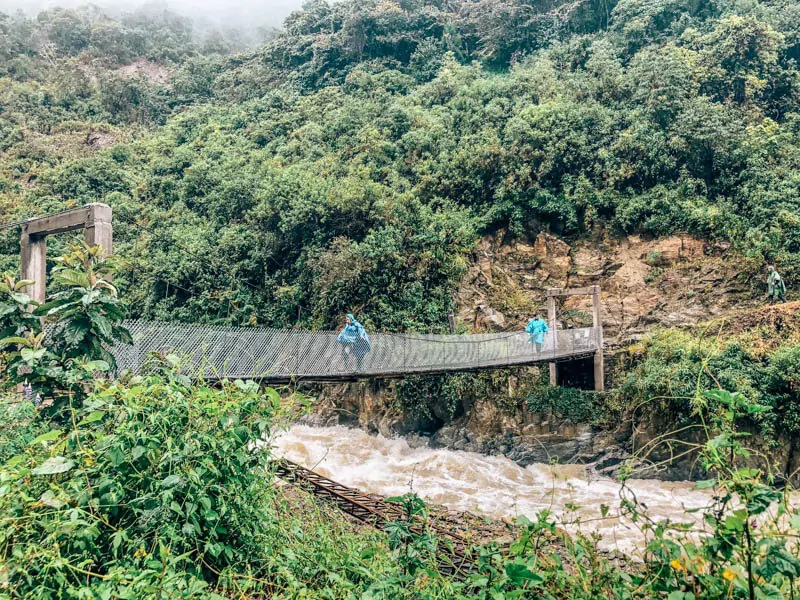
A Pit Stop at a Coffee Plantation
It was pretty much smooth sailing for the rest of the day. Stopping at a coffee farm along the way to sample the local brew. As I’m not a coffee drinker, I opted out of the sample, but the coffee drinkers of the group said it was quite delicious.
Since the walk had taken us longer due to the landslides, a bus appeared to take us the remainder of the way to our campsite.
This meant we would not miss the hot springs!
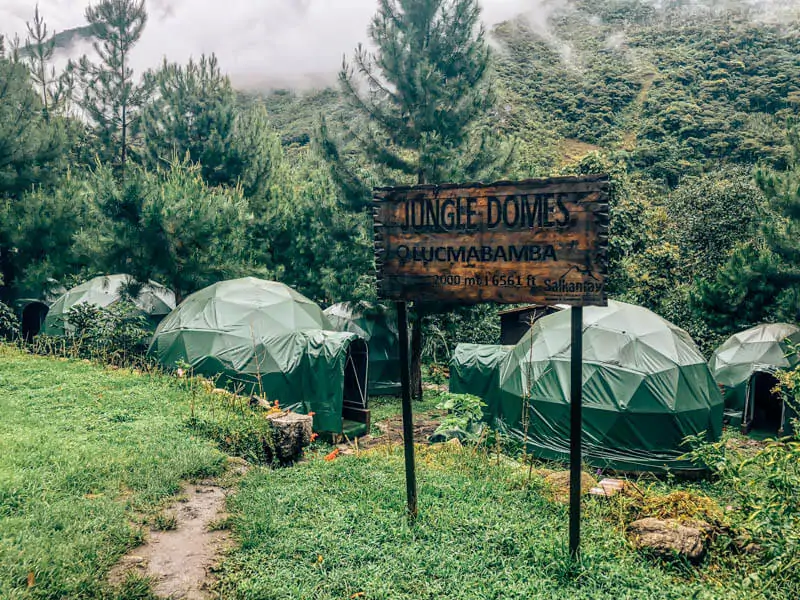
The Hot Springs
A bus took us to the hot springs which were about an hour away from our campsite. We had two glorious hours to relax in the various springs.
The temperature in the pools ranged from crazy hot to lukewarm. And there were showers with frigid water to cool off in between pools.
I felt my muscles release tension as I stretched in the hot water and then jumped under a cold shower to help decrease some inflammation. Side Note: The hot springs are not included in the price of the Salkantay Trek as they are an optional part of the trek. Although, who would skip such a lovely and relaxing option?! These hot springs were one of the reasons I opted for the Salkantay Trek instead of the Inca trail.
Lodging Night Three: Jungle Domes in Lucmabamba
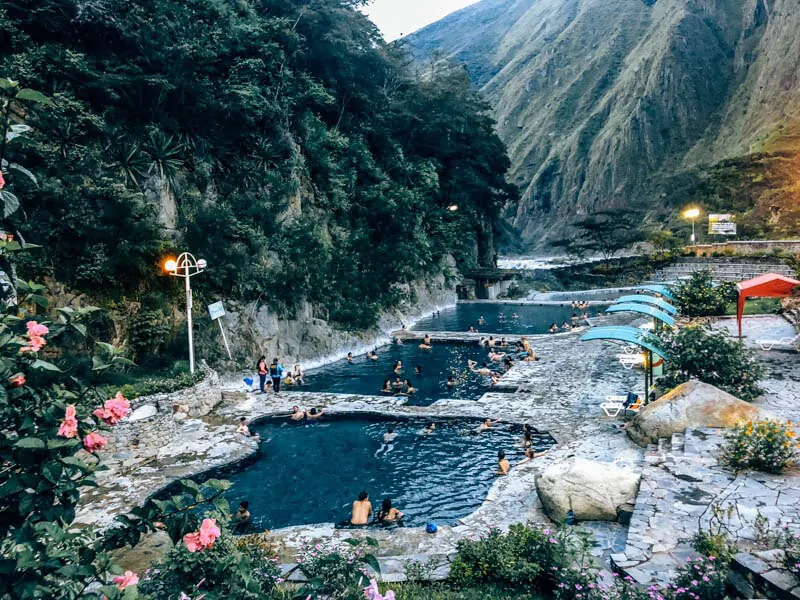
Day 4 of the Salkantay Trek: Lucmabamba to Aguas Calientes
The fourth day after being woken with fresh coca tea, a routine I was growing very fond of, we were presented with an option. If our bodies were done, we could take a van to Aguas Calientes, our day’s destination. As tempting as that van sounded and as much my back hurt, feet ached, and shoulders did not want to carry my backpack. As much as I wanted to spend a few hours in a van compared to six hours walking, that’s not what I came here for. I came here to walk to Machu Picchu.
The day that we joined the Inca Trail would not become the day I quit!
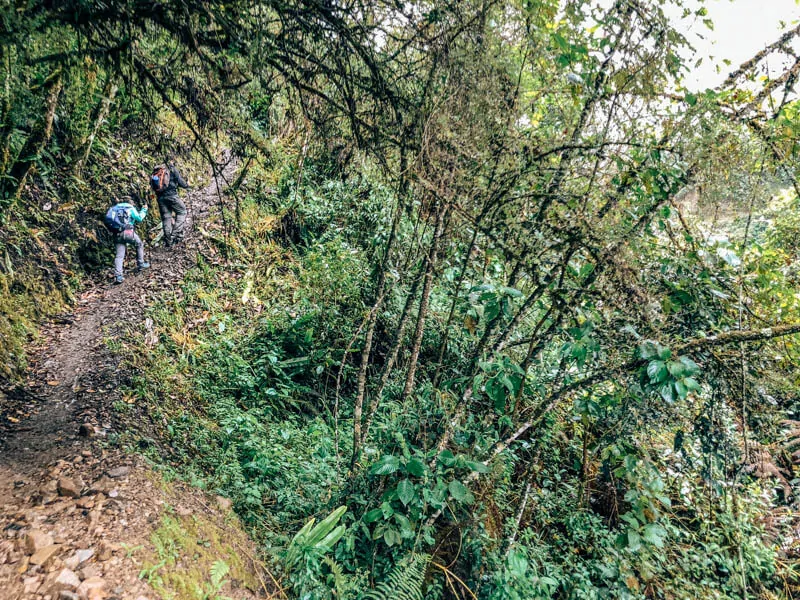
So, I filled up my water bottle, loaded up my backpack, filled my head with positive self-talk and walked uphill for two hours on a section of the Inca Trail.
We passed beautiful vistas of the valley below us coming to a stopping point with a hut selling snacks and beer. I purchased some peanut M&Ms while the guy from Colorado purchased a beer. We all have our needs on the trail!
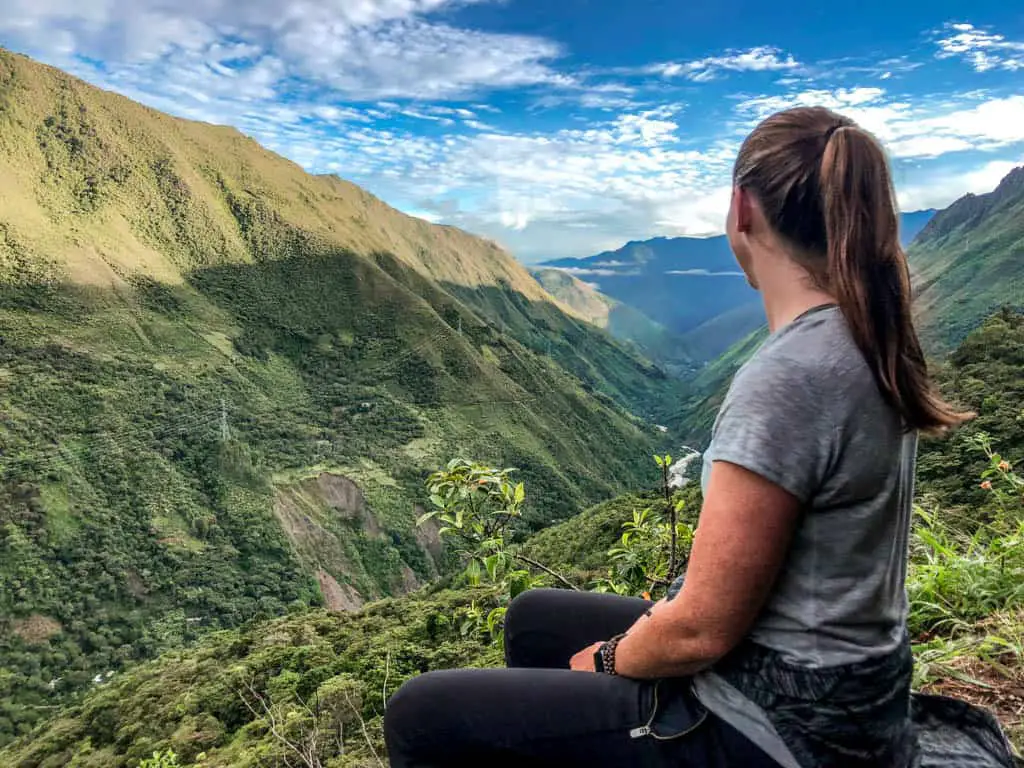
Before we’d left that morning, I’d switched into a new pair of socks as the ones I’d been wearing for the first three days were still wet from the waterfall. I noticed the new, dry socks, were starting to give me blisters on my heels.
Llactapata
Deciding to ignore it we arrived at our first Incan ruin of the trip, Llactapata. Llactapata served as the checkpoint for Incan messengers heading to Machu Picchu. Across the valley, in the distance, we caught our first glimpse of Machu Picchu. Nestled in between the mountains, on the edge of a cliff.
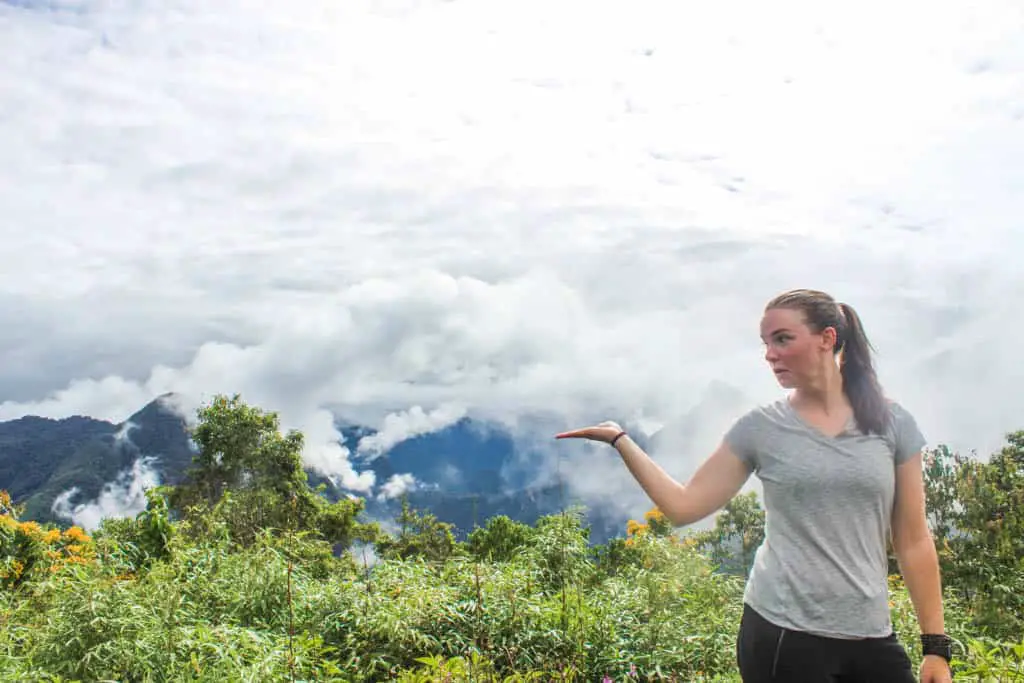
Seeing Machu Picchu from a distance made me wonder – Why here? How did they know this place existed? How did they get there? I hoped that our guide would answer these as I took some photos and switched my socks back to the original pair.
Blisters are the worst.
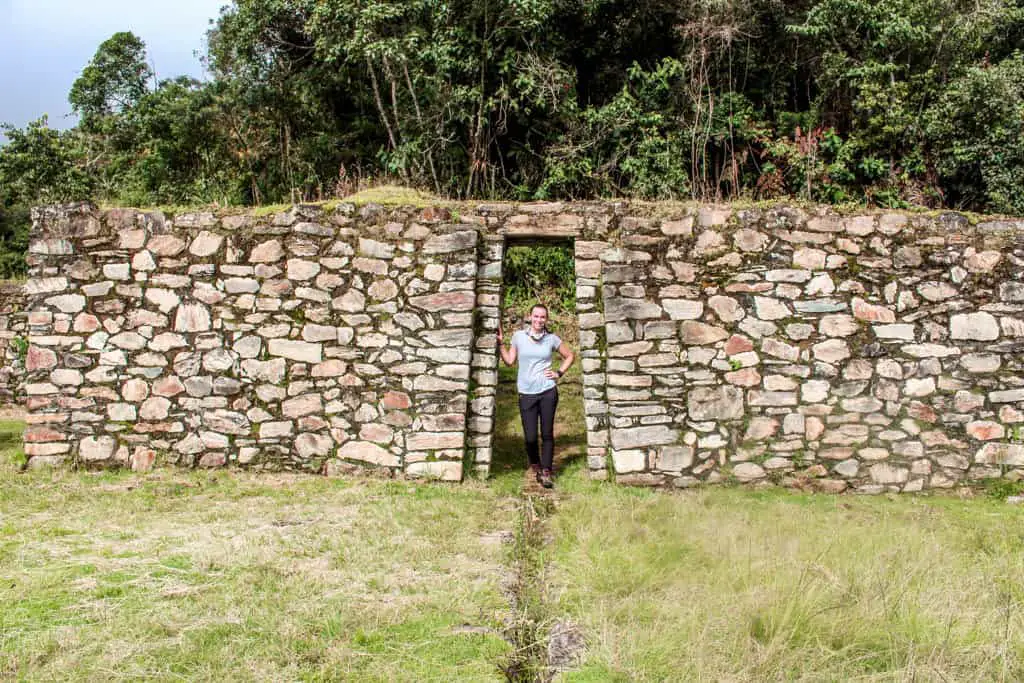
My feet feeling much happier and my head still filled with questions, we pressed on.
The sun decided to come out from hiding as we walked downhill, mostly under the cover of trees. I realized I preferred the rain the past few days as the sun was incredibly hot.
As annoying as it was being wet, it would’ve been worse to have gotten a sunburn! It’s one thing to have sore and achy shoulders, it’s another to have sore, achy, sunburned shoulders.
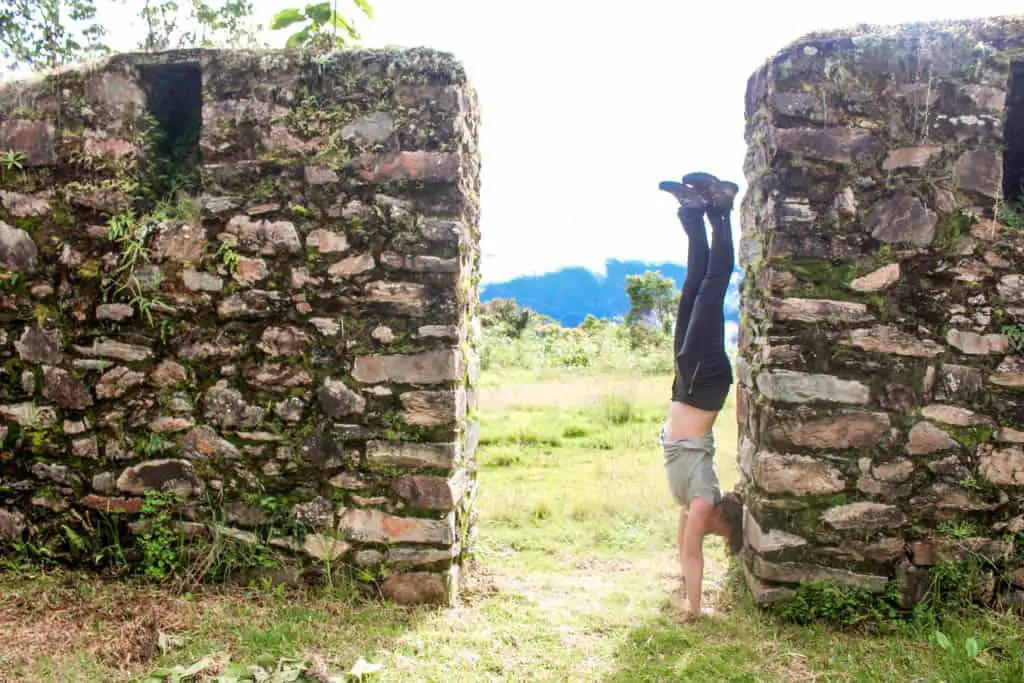
Following the Train Tracks to Aguas Calientes
We finally reached our lunch spot, a restaurant that was a well-oiled machine serving hungry hikers. They had us fed and happy in about thirty minutes, then sent us off to follow the train tracks to the town of Aguas Calientes. This part of the path was the easiest physically, but hardest mentally.
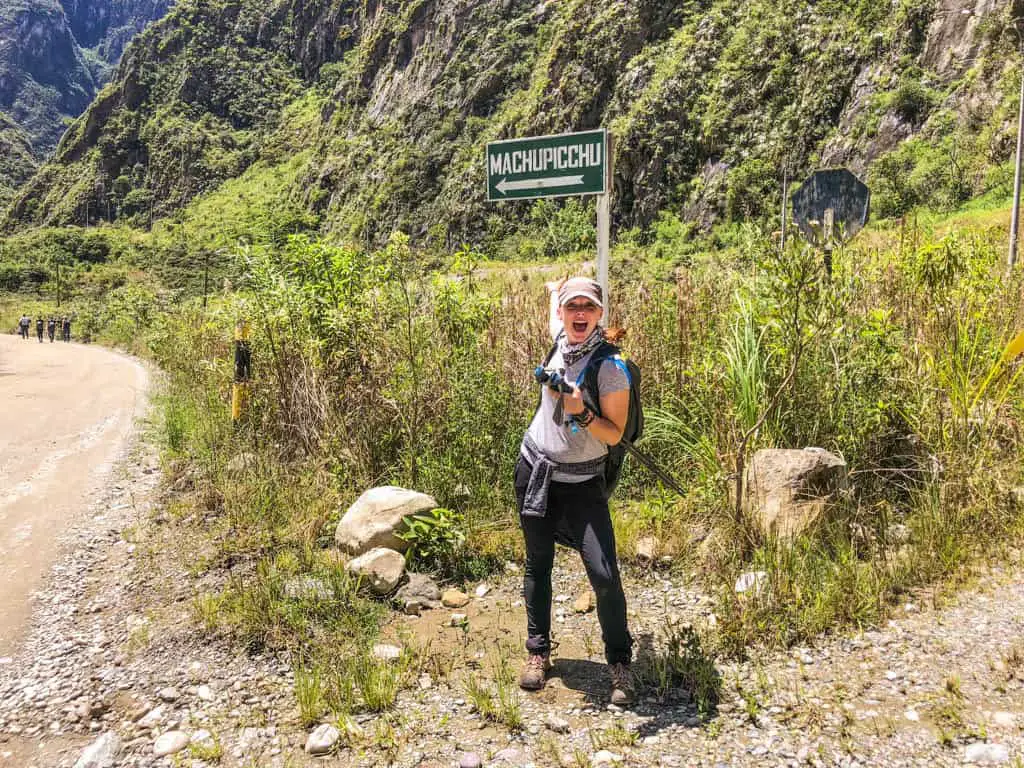
We were so close to Machu Picchu. Every step I knew was taking me there, yet every step grew more and more painful to make.
At one point the guy from Colorado turned on a speaker to play some Reggaeton, hoping to lift our spirits and put a little pep in our step.
The group grew quiet, everyone in their own heads.
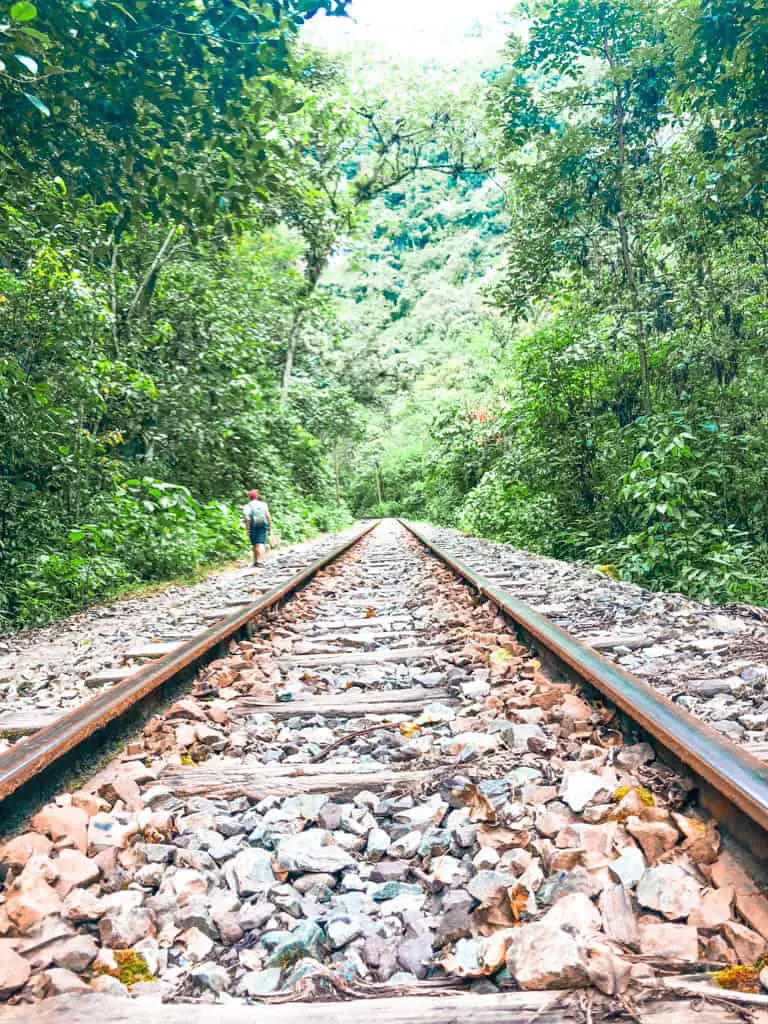
Arriving in Aguas Calientes
Finally, we set foot in Aguas Calientes, where we checked into our hotel and I took my first hot shower in four days. The water was hot, the pressure strong and if it hadn’t been a hotel shower I could’ve sat on the floor and just let the water run over my sore body.
Even though the weather turned back to rainy and cold, I put my flip flops on to give my feet a break as we headed out to dinner. Our last meal together as a group.
Over dinner, our guides described the following day: Machu Picchu day! We had two options for getting to Machu Picchu. We could take the bus from Aguas Calientes or we could walk the steps. Our guides told us that the steps were made after Machu Picchu was discovered, so we wouldn’t be missing anything if we opted for the bus.
He also recommended that since I was hiking Machu Picchu Mountain, I should take the bus to save my energy.
I am so glad I listened to his words of advice, buying my bus ticket after dinner. I returned to the hotel for a well-deserved rest.
Lodging Night Three: A hotel in Aguas Calientes
Day 5 of the Salkantay Trek: Machu Picchu
The final day of the Salkantay Trek to Machu Picchu arrived!
The first bus to Machu Picchu was at 5:30 am and we joined the ten other people already in line at 4:00 am. Vendors worked the line, selling coffee and snacks to those patiently waiting.
Our hotel had provided a sack breakfast which I happily ate while waiting for the bus.
The bus arrived at the gates of Machu Picchu just as the sun was rising.
We were one of the first twenty people to enter Machu Picchu as it opened at 6:00 am.
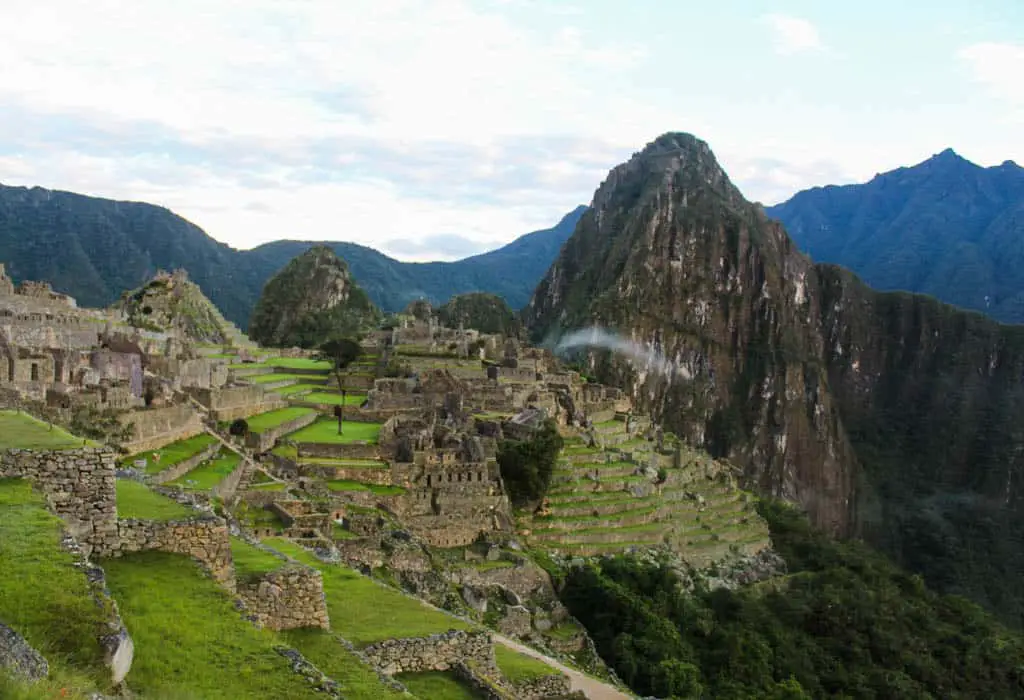
Machu Picchu
It was surreal being one of the very few people in Machu Picchu with the slowly brightening early morning sky and mountains as our backdrop; the birds chirping the only sound. The morning fog moved across the buildings giving Machu Picchu an even more mystical appearance. I got to sense what it was like in the quiet mornings hundreds of years ago.
The Incas waking with the sun, surrounded by these mountains, working on these buildings, studying, and going to bed with the sun. Living in accordance with the rhythm of nature.
“It’s an irritating reality that many places and events defy description. Angkor Wat and Machu Picchu, for instance, seem to demand silence, like a love affair you can never talk about. For a while after, you fumble for words, trying vainly to assemble a private narrative, an explanation, a comfortable way to frame where you’ve been and what’s happened. In the end, you’re just happy you were there — with your eyes open — and lived to see it.”
— Anthony Bourdain, The Nasty Bits
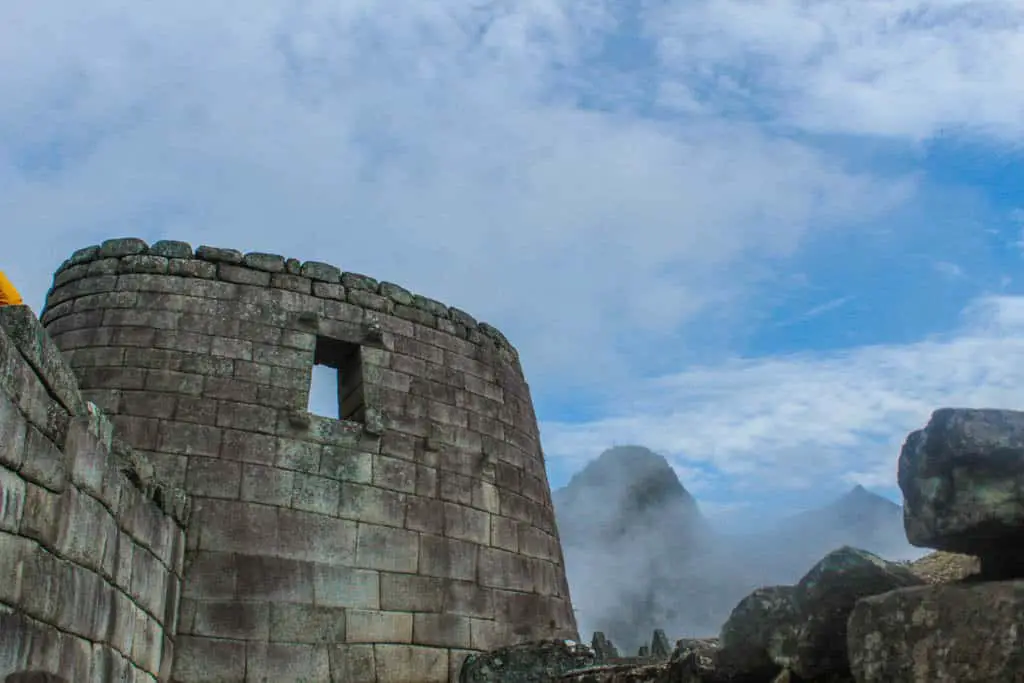
We walked along the terraces that were once used to grow crops for those building Machu Picchu as our guide described the history of this landmark. We learned about the Temple of the Sun and Water without being crowded by other tourist groups. Our guide described how the Incas made the buildings in accordance with the rhythms of the earth. Some buildings perfectly aligned for the solstice, others honoring the shapes of the mountains surrounding them, and even rocks carved in the accurate shape of a compass.
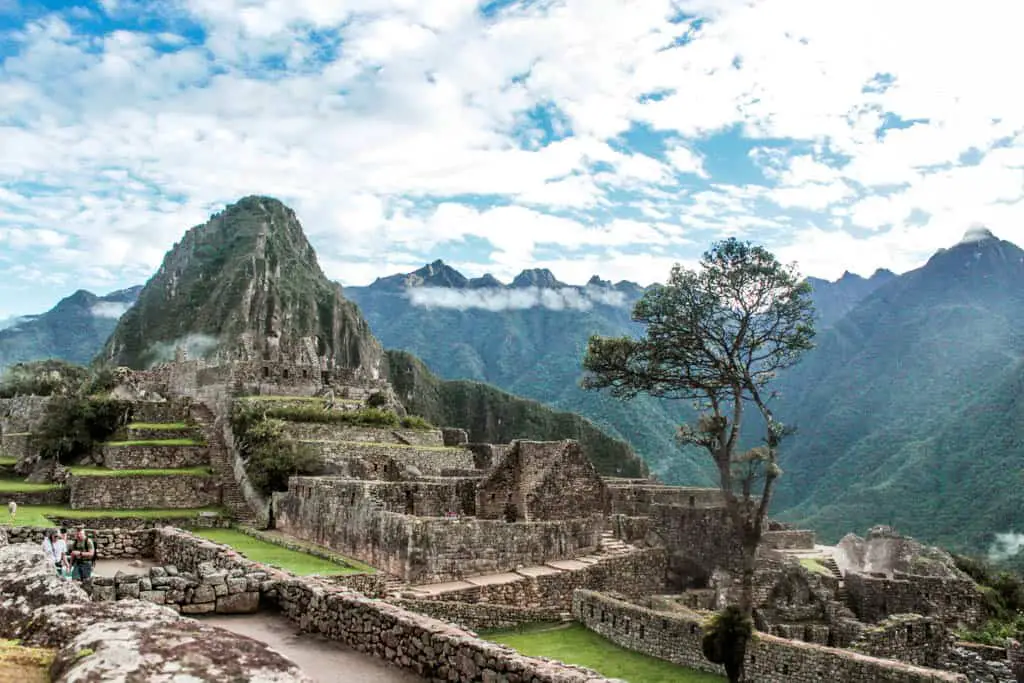
Most importantly, we learned the correct way to say Picchu. The way it is commonly pronounced is “Pee-chu”…which means penis in Quechua. The correct way to say it is “Pict – chu”, the first half pronounced liked “pict” in picture. Which then correctly translates to mountain.
After about two hours, our guides left us to our own devices. They had to return to Cusco to prepare for another tour leaving the next day.
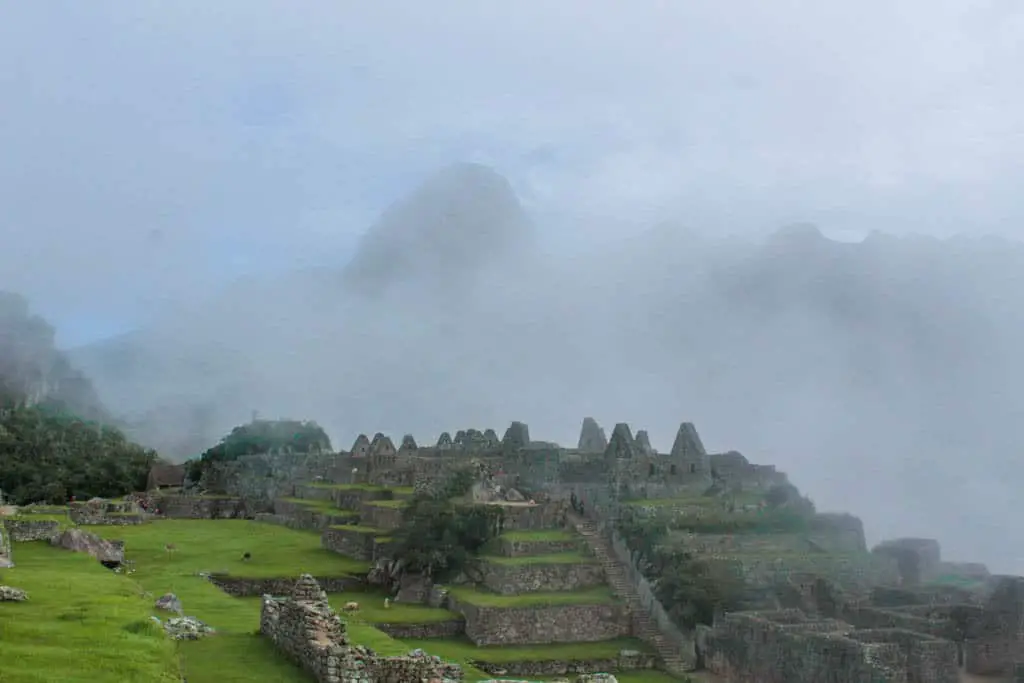
Hiking Machu Picchu Mountain
The three Coloradoans and I were the only of our group planning to hike up Machu Picchu Mountain. I had a ticket for 9:00 am to climb Machu Picchu mountain. And as much my body said no, I’d already paid for the ticket and $60 was not going to waste!
So, I began my climb. Grateful to be escaping the growing crowds as I climbed step after step. The steps up to the top were on the edge of the cliff, rocky, and incredibly steep. At times I used my hands and my feet, basically crawling up the mountain.
Machu Picchu growing smaller as I climbed. Each time I passed someone making their way down, I asked how much further?
Ten more minutes, ten more minutes, ten more minutes
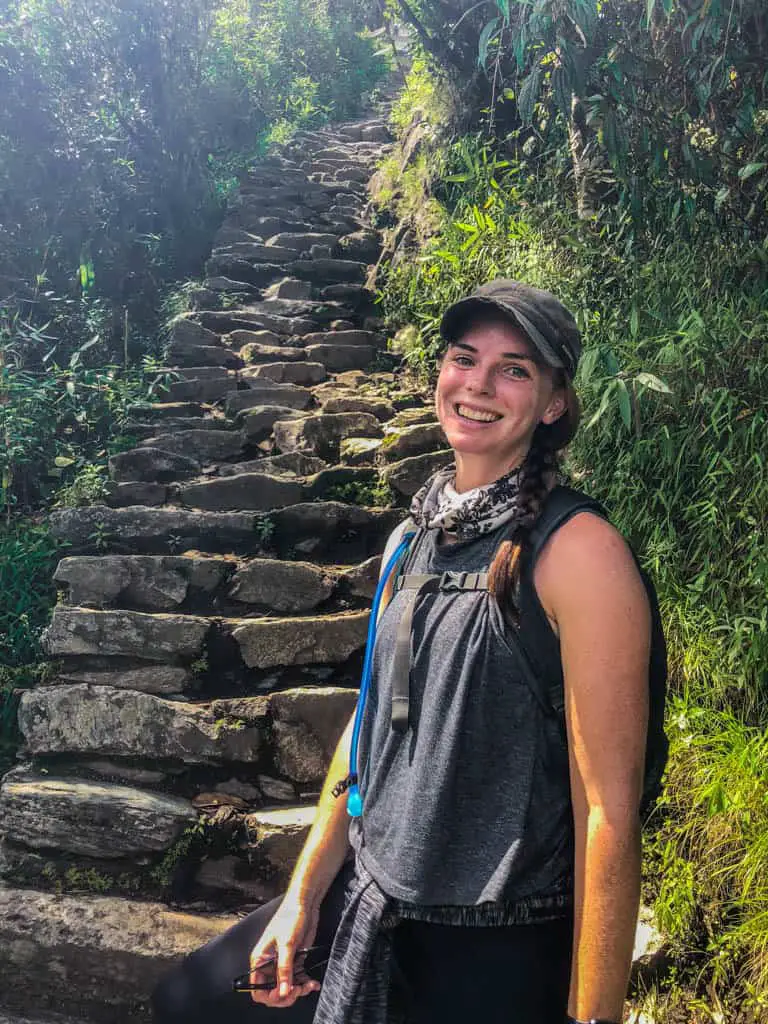
Finally, I made it to the top, where the seasoned Colorado hikers were already relaxing with the view of Machu Picchu below and Huayna Picchu (another possible hike) just behind it, offering its protection.
I stood there in awe of what the Incas built. The sophistication and knowledge that they had to produce something of this magnitude. Knowledge learned from years of observing the natural rhythms of the earth, then passing that knowledge down, generation to generation. Perhaps they knew that they would likely not see the fruits of their labor in their lifetime. Yet, they still worked on it.
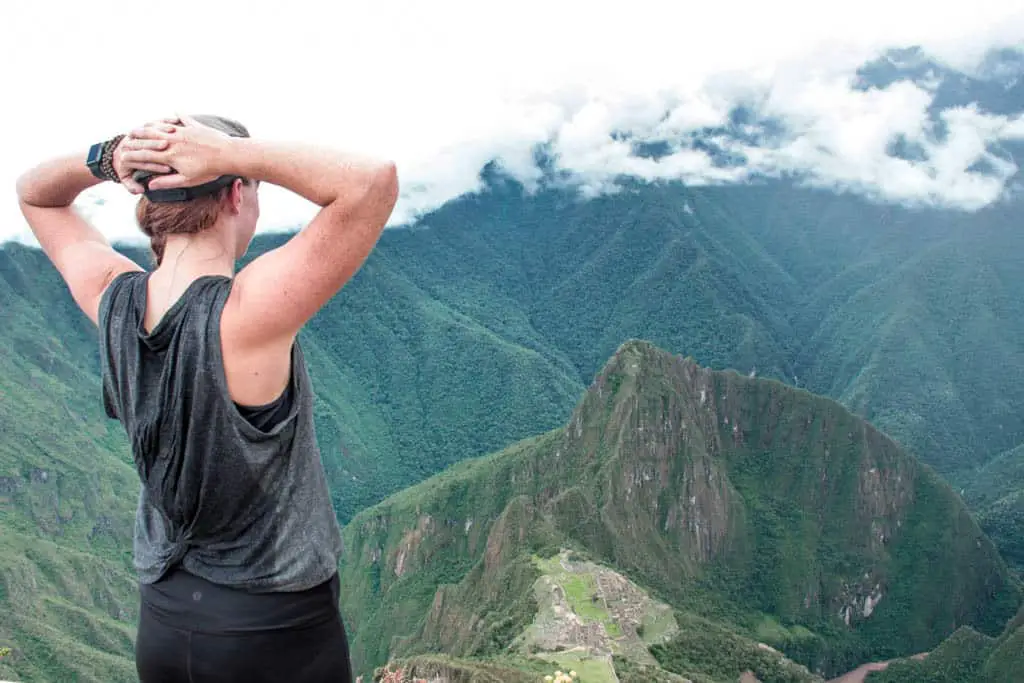
As we were up in the clouds, looking down on this ancient artifact, the thunder started. Could it get any more magical than listening to the thunder in the distance as the fog rolls in and out over Machu Picchu? I could’ve stayed up there for hours. Yet, we had to return so we began the climb down. Creaky knee after creaky knee down those steep staircases.
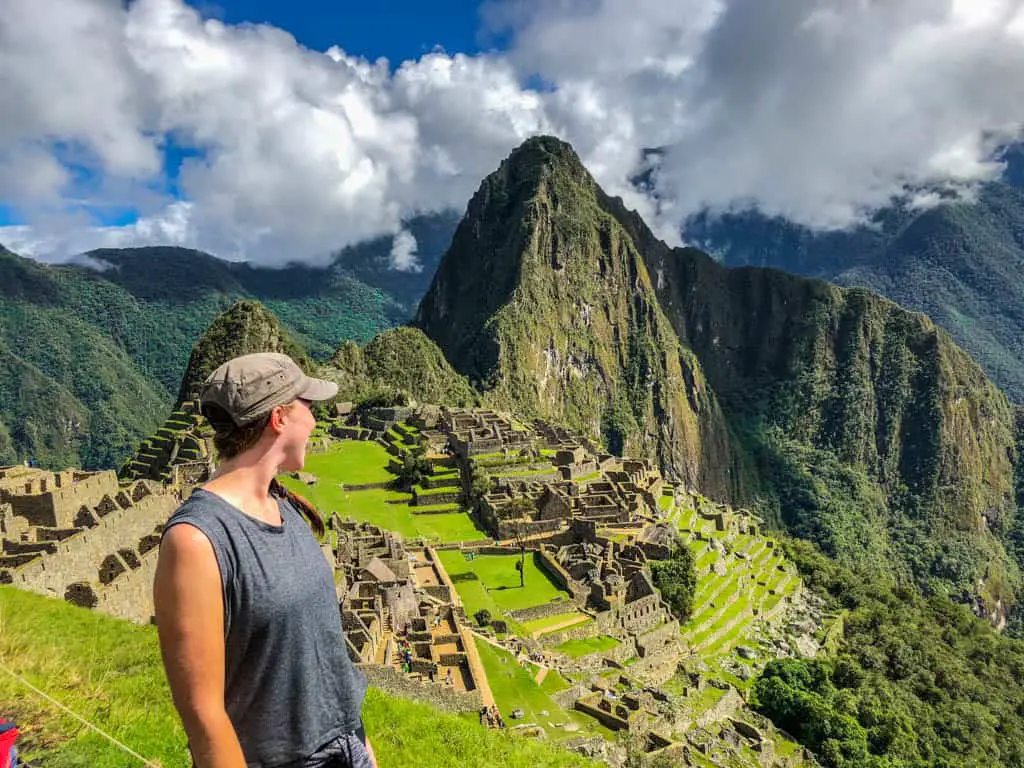
The throngs of tourists had decreased during my hike, so I slowly wandered through the rest of the grounds of Machu Picchu. I visited the freely roaming alpacas. I took my time to sit, watch, and listen. Finding quiet spaces where there was no one else to take this experience in as much as I could.
Knowing that the past 5 days would soon become a memory as I exited the gates. Returned to my hotel. Removed my hiking boots and headed to the train station to return to Cusco.
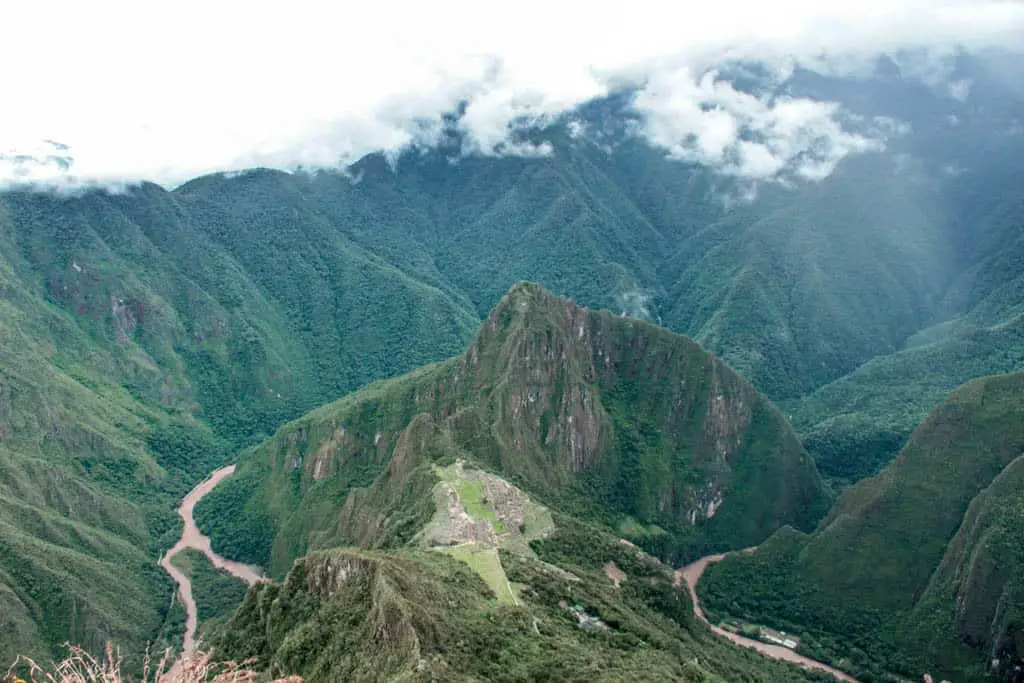
FAQs for the Salkantay Trek to Machu Picchu
What Company Did You Book With?
I booked with Salkantay Trekking. The guides were incredibly professional, well-trained, and encouraging when the hike got difficult!
This company also does guided Inca Trail treks and hikes to Rainbow Mountain.
What trek did you choose?
This blog post details the classic Salkantay Trek, which is 5 days and 4 nights. There are shorter and longer options as well.
How Difficult is the Salkantay Trek?
Difficulty is all relative. The guy from Colorado practically ran up the Salkantay Pass.
But, you should be in decent shape before attempting this.
It is a very physically challenging hike. Thankfully, you’ll have experienced guides with you the entire time!
Also, make sure to spend a few days in Cusco prior to the trek to acclimatize to the altitude.
Thankfully, there are a ton of fun things to do in Cusco while you acclimatize.
What was Included in the Cost?
Prices and offerings are always subject to change, per the company. So, I highly suggest checking out their website for the most up-to-date information.
However, here is what was included:
- The cost of the Machu Picchu Tickets
- Duffle bag
- Medical & First Aid Kit
- Tour guides who had a satellite phone as there is no cell service
- Amazing campsite accommodation and a comfortable hotel in Aguas Calientes on the final night
- 5 breakfasts, 4 lunches, and 4 dinners
- Filtered water
- Coca Tea and leaves
- Trail snacks
- Transportation
If you need to rent any equipment from them, there is an additional fee. I had to rent the following from them:
- Sleeping bag
- Trekking poles (highly recommend)
Additional Machu Picchu Hikes
There are two hikes within the Machu Picchu archaeological site: Huayna Picchu and Machu Picchu Mountain.
If you want to hike either of those, there is an extra cost. However, you can pay it through them and they will take care of securing your ticket.
Do I Need to Bring Extra Cash?
Yes.
There is a $10 fee on the first day for the upkeep of the Salkantay trail.
There are also places to purchase snacks along the way and places to use the restroom (for 1 sole). So, have small coins on hand as well.
You’ll also need to tip the horsemen, the cooks, and your guides. They certainly deserve it!
What do you need to pack for the Salkantay Trek?
During the hikes, you’ll keep only what you need in your day bag. The rest will go in the duffle bag that gets carried by mules from place to place for you.
Your Salkantay Trek packing list should consist of the following items:
- 1-2 pairs of hiking pants: Wear one for the entire trek. Keep a clean pair for Machu Picchu day.
- 2-3 workout tops: A clean shirt to sleep in, one to hike in, and a clean one for Machu Picchu Day
- ¼ zip fleece: The Patagonia one or something similar like this affordable Columbia sweater is perfect for layers on the hike and to stay cozy at the campsite
- Pair of Joggers: A pair of sweats, leggings, or joggers to sleep in at camp.
- 7 pairs of underwear: Always bring more underwear than you think you’ll need. I love ex-officio underwear for hiking and travel.
- 2 sports bras: One to wear during the trek, and a clean one for Machu Picchu day
- Swimsuit for the hot springs
- 2-3 pairs of Darn Tough socks (these did not give me a blister) they’re literally the best socks ever and worth the cost. Get your Darn Tough socks here!
- Thermals: It gets cold at the high altitudes you’ll reach. I wore these ones and they were super comfortable.
- Waterproof hiking boots: I loved my Keens and they held up so well on this rainy trek! Get your hiking boots here.
- Camp sandals: There was nothing better than slipping on a pair of sandals at the end of the day. I recommend Tevas or something similar so you can wear them to the hot springs as well.
- Hydration Pack: The company will provide you with water, so have a hydration pack. I used a 2L one and it was sufficient. I could fill it up at lunch as well.
- Snacks: While the company will provide trail snacks, pack the ones that you love while hiking as well.
- Camera: Whether you use your phone or a digital camera, you will want to be taking photos! The beauty of doing this trek as a solo traveler is you’ll have people in your group to take photos of you! That’s one way I get photos when traveling alone.
- Portable Charger: This Mophie charger will keep your devices charged for five days! I love that thing!
- Toiletries: Sunscreen, face wash, medications, glass and contacts, deodorant etc. With the exception of sunscreen, these items can go in your duffel bag. Also, don’t forget bug-repellent. These bug-repellent wipes worked so well!
- Rain gear: If you’re doing this hike in the rainy season you will want quality rain gear – not a cheap poncho! Bring rain pants, a rain jacket, and a rain cover for your backpack.
- Hat & Sunglasses: Protect your face and eyes!
- Gloves & Beanie: Again it gets cold out at night and in the early morning! You may want gloves and. a beanie. I can confirm I used them!
- Travel Insurance: Don’t forget travel insurance! As this is such a physically demanding hike, travel insurance is essential. I use World Nomads or Safety Wing depending on the cost for the trip and required coverage.
You can shop my entire Machu Picchu packing list here.
Why Didn’t You Do the Classic Inca Trail?
I debated for a while about doing the Inca trail vs the Salkantay Trek. Ultimately, I had to consider what I wanted out of the trek. I found the Salkantay Trek provided more natural landscapes like Humantay Lake, which I really wanted to see!
The Salkantay Trek also joins the Inca Trail on the second to last day, so I was really getting the best of both worlds.
The Salkantay Trek is one of the best treks in the world, so it’s a solid alternative to the Inca trail.
When is the Best Time of Year to Do this Trek?
As you can tell, I did this trek in March which is the rainy season. The weather conditions were certainly challenging.
That’s why the dry season, which is May to October, is the peak season for hiking the Salkantay Trek and visiting Machu Picchu in general. You’ll have clear and sunny days, dry trails, and amazing views!
If you’re visiting the Cusco region during peak season, it’s another reason to consider the Salkantay Trek as it will be less crowded than the Inca Trail.
Was Machu Picchu Crowded?
Yes. When we arrived at 6:00 am, there were very few people there. However, it got busy quickly and when I began my climb to Machu Picchu mountain at 9:00 am it was seriously overcrowded with people.
Yet, when I returned a few hours later, the crowds seemed to dissipate.
For this reason, I highly suggest arriving early and then hiking one of the other mountains during peak times and then returning to enjoy this place in relative peace.
I hope this half personal experience half how to hike the Salkantay Trek to Machu Picchu post inspires you to book this amazing Peru trek. It’s a truly unique experience that includes a balanced combination of historical sites and stunning landscapes. Yes, it’s a physical challenge, but it is so rewarding! I hope that you have a great time!
Like this post? Pin it to Pinterest!




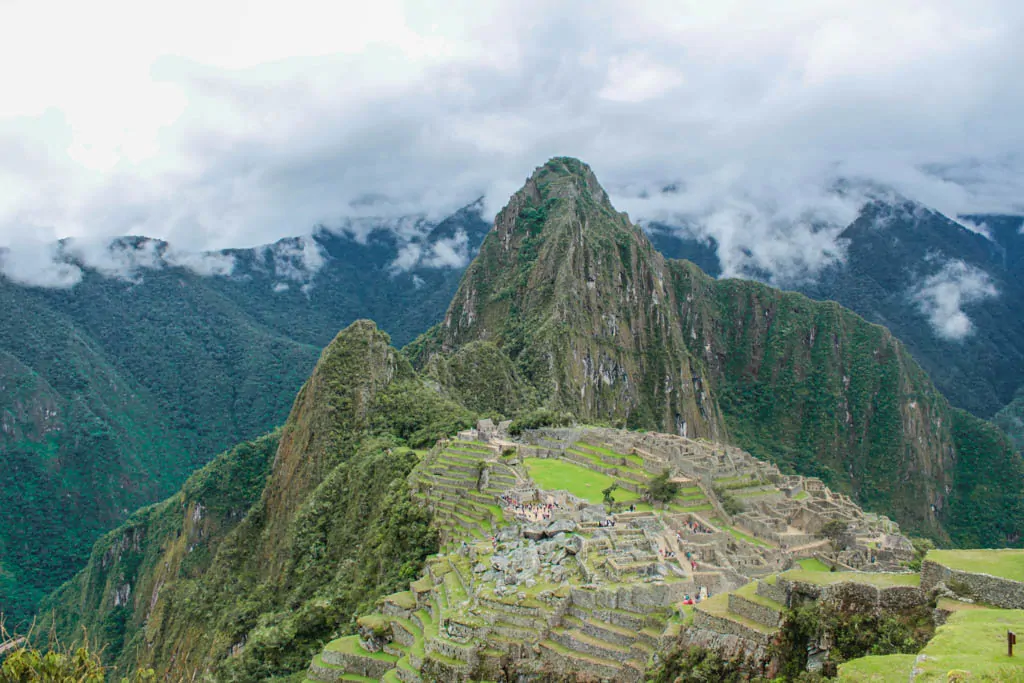
Great post and I love the photos. I have not seen anything on this route before, and the scenery is amazing, especially Humantay Lake. Looks like both a challenging and rewarding hike.
Humantay Lake was stunning! Highly recommend it if you’re ever in Peru! I believe there are day hike options
Wow, this sounds so epic! I’m exhausted just reading about your trek haha. I think the hot springs are a must if you are going to do this. What a great way to relax after a grueling hike. Well done you! Did you feel the coca leaves helped with the altitude?
Hey Scott! It was quite the trek and the hot springs were AMAZING afterward. To be honest, I don’t think the coca leaves helped at all haha! The air is so thin at that altitude that breathing is incredibly difficult…but I didn’t get nauseous at all so maybe they did a little bit?